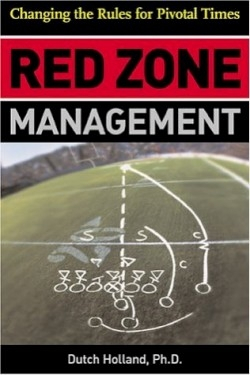Red Zone Management
Changing Rules for Pivotal Times
Few would argue that professional sports are big business today, but it seems that the converse is true: big businesses are being run like football franchises. Charismatic business leaders are interviewed for popular magazines; business developments are featured in highlight reels; and sports metaphors dominate the lexicon. Capitalizing on this trend, the author, himself CEO of a management consulting firm, has come up with a playbook for businesses facing crucial turning points in their operations. In professional football, the “red zone” refers to the last twenty yards needed to score a touchdown. Teams in the red zone either score the needed points or are turned back, suffering at best a demoralizing blow, at worst a devastating loss. According to Holland, as pro teams fare in the red zone, so do businesses: it’s “make or break time.”
In his first four chapters, the author documents the problems faced by companies in the red zone, details the different maneuvers that put businesses there (such as changing the company’s strategy or implementing e-business solutions), dissects why so many companies fail to deliver in the red zone, and delivers ten principles “that need to be applied in the red zone, regardless of the company or the red zone condition.”
Then, he examines case studies of companies that reached the end zone versus companies that came up empty. For example, Chapter Five is “the primer on changing competitive strategy,” which, says Holland, is the toughest of the red zone maneuvers, because it affects the total organization and has an immediate impact on a company’s customers. Following an overview of the perils of undertaking this strategy, Holland presents case studies of Telus and Toys R Us, one company that scored and one that fumbled. Completing the chapter is an analysis of how the ten red zone principles should have been applied to this business maneuver.
The title notwithstanding, football metaphors are not overused in the book, so even those who wouldn’t know an end zone from a construction zone will still benefit from its crisp language and straightforward organization. Anyone in business knows that opportunities can quickly become disasters if not played correctly, and Holland’s book diagrams the plays. In fact, the motto of the book may be more akin to the Boy Scouts’: be prepared. Because when crunch time comes, as it inevitably will, no businessperson wants to be left holding the ball.
Disclosure: This article is not an endorsement, but a review. The publisher of this book provided free copies of the book to have their book reviewed by a professional reviewer. No fee was paid by the publisher for this review. Foreword Reviews only recommends books that we love. Foreword Magazine, Inc. is disclosing this in accordance with the Federal Trade Commission’s 16 CFR, Part 255.

